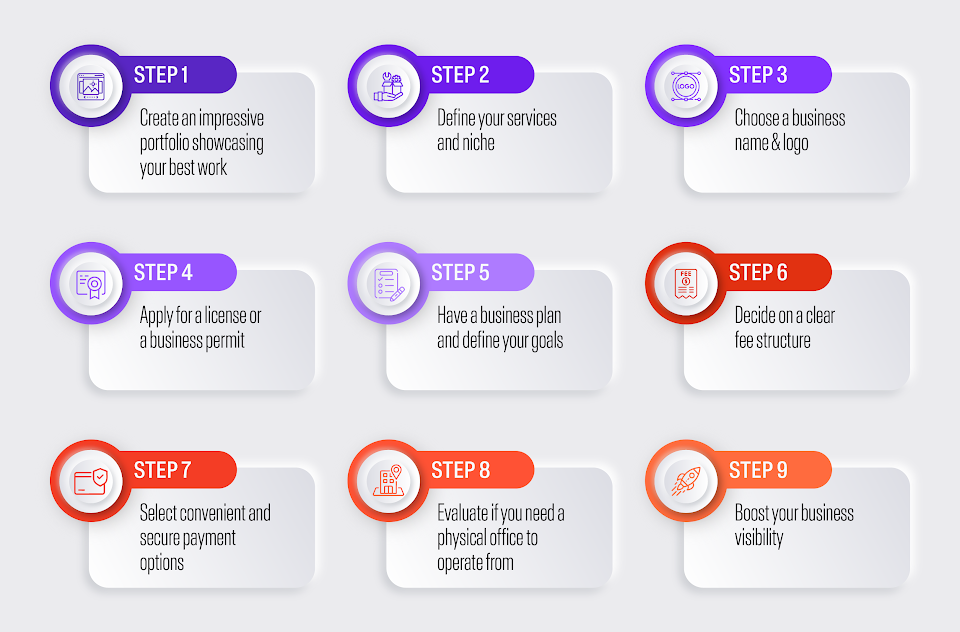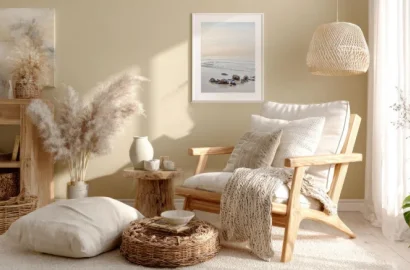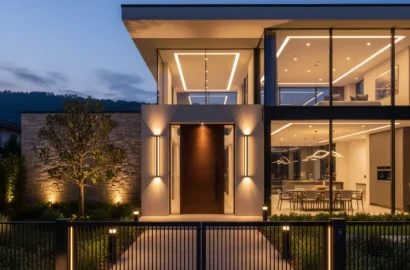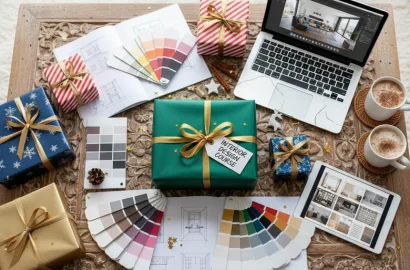If you’re looking to start your own interior design business and make a mark in the industry, this step-by-step guide might be just what you need.
An interior design business involves working with clients to design, upgrade, or renovate indoor spaces, ensuring they are functionally sound and aesthetically engaging. Interior designers are essentially responsible for spatial planning, furniture design and selection, optimal lighting, storage solutions, and the integration of appropriate decor elements to maximize the potential of a space.
Working for a design firm or with one of the established interior designers can be a first step, offering exposure and first-hand industry knowledge. However, if you have the passion and skill for interior design and want to showcase your capabilities, launching your own business can also be a rewarding option. By working with homeowners, real estate agencies, retail shops, rental apartments, hospitals, and schools and collaborating with civil engineers and architects, you can diversify your projects, earn a steady income, and establish your mark in the industry.

This comprehensive guide will walk you through the essential steps to starting your interior design business. Whether you aim to work directly with clients or collaborate with other stakeholders, we’ve got you covered.
Here’s a clickable link to all the steps we’ll cover in this article!
Contents:
- Create an Impressive Portfolio
- Define the Services That You Want To Offer
- Choose a Unique Business Name & Logo
- Apply for a Licence or Business Permit
- Create a Business Plan
- Decide Your Design Fee Structure
- Define Payment Methods
- Create a Digital Visibility
- Evaluate if You Need a Physical Office
- Summing It Up
How To Start a Successful Interior Design Business?
Before we move on to the steps, it is important to understand that there is no defined roadmap to being an entrepreneur or determining one’s success beforehand. What’s important is to recognize your potential and start learning the ropes of an interior design business.
Growing a successful interior design business involves navigating challenges, from developing a brand identity to converting leads into clients, outsourcing, and hiring the right staff. It is often a fair share of trial and error. Here are some essential steps to help you out. So, let’s get started.
1. Create an Impressive Portfolio

An impressive interior design portfolio is your unique selling point— an opportunity to showcase your best works in front of potential clients. It’s wise to include various stages of your interior design process to give a deeper insight into your style. Here are a few things that you can consider adding to your portfolio:
Rendered Drawings & Images
Include both 2D and 3D rendered drawings for better visuals, highlighting room layouts, walls, furniture, doors, and window placements. Emphasize how built-in elements like wardrobe, bathroom and kitchen cabinets, and other storage solutions are strategically and aesthetically planned through intuitive graphics. Use high-quality renders and client testimonials showing various design stages, from initial sketches to final 3D models of completed projects and add relevant credibility to your work experience.
Mood boards

Demonstrate your versatility by presenting a range of design, color, and material palettes. Tailor interior design mood boards to different tastes and preferences to target a wider market. For past projects, include palettes inspired by specific client requests to show your ability to meet customized needs. Add brief descriptions to explain your choices and how they contribute to creating comfortable yet polished interior spaces.
Personalized Styling Recommendations
Highlight your expertise in making informed purchasing decisions for varying clients. Showcase your recommendations for furniture, appliances, and decor items, ensuring they align with both quality standards and budget constraints. Demonstrate how your selections reflect a personalized style and enhance the overall design.
Initial Design Projects
For any small projects done for yourself, friends, or family, capture high-quality photos from multiple angles with good lighting. Before-and-after photos are particularly effective in showcasing the transition. Explain the color palette, room layout, and material selection alongside the images. For reference, you can take a look at AND learner Pawanjot Singh’s Interior Design Portfolio.

2. Define the Services That You Want To Offer
Choose your interior design services based on your strengths. Identify what is your forte and select the type of properties that highlight your expertise. If you’re good at designing residential interiors, offer services specifically for individual homes, villas, or apartments. Similarly, if you have a thing for designing commercial interiors, offer services for offices and retail spaces.
Once you’ve done that, select the services where you can outperform your competitors. While you can provide generalized services, your specialized services will help you stand out in the crowd. Here are some of the services that you can offer as an interior designer:
Space Planning & Home Decor
Here, you are responsible for planning the indoor spaces, defining the interior style, finalizing a color palette, choosing appropriate materials that fit the style, deciding on the furniture and decor pieces, and creating sufficient storage units for your clients.
Furniture Selection
If you’re well-connected with a handful of skilled furniture designers, artisans, local dealers or auction houses, you must use this opportunity and offer this niche service. Additionally, you can refer your clients to reputed furniture stores that deal in distinct pieces of furniture.
Color Consultation
With this service, you can help clients identify the color palette that suits their interior design style as per their preferences and the lighting conditions of the space.
Project Management
In this case, the onus is on you to ensure complete management of the interior design project, from conceptual design to final execution, maintaining on-time delivery and budget constraints.
Online Design
With online design, you can offer virtual design services by analyzing the client’s space and developing a design, giving them a clear visual representation of your proposed concepts. Your clients can use these drawings, renders, and estimations and materialize the design with the help of a contractor at their respective locations.
3. Choose a Unique Business Name & Logo
Choose an interior design business name that hints at your expertise and reflects your personality. Many designers use their names to build their brands, while others opt for a more creative name, which gives a sneak peek into their unique business idea. Having a business name is also important for separating your professional and personal finances. Once you’ve chosen your business name, decide on your logo and register your business to secure your brand identity.
Pro Tip: Design and print your business cards. A business card signals to your potential clients that you run an established, legitimate business with a professional email and contact number. Keep a few cards with you at all times—they’re invaluable for networking opportunities that arise unexpectedly.

4. Apply for a Licence or Business Permit
Once you have chosen the name of your interior design business, the next step is to apply for a business license. Whether you operate from home or an office, a valid business license is essential. The cost of obtaining this license is minimal compared to the substantial fines you could face if the IRS investigates your business.
Depending on the scale of your business and future plans, decide on a legal structure for your business. You can register your interior design business as:
- Private Limited Company
- One Person Company
- LLP (Limited Liability Partnership)
- Sole Proprietorship
- Partnership
Pro Tip: Private limited company registration is the most common and trusted business structure.
Once you’ve decided among these options, apply for a business license. A business license registers you as an independent business owner, allowing you to conduct financial transactions under your brand name, separate from your personal finances. Having an interior design business license not only legitimizes your operations but also assures clients of your credibility, ensuring they can trust you with their investments. It also enables you to participate in trade shows and exhibitions, providing opportunities to attract new clients and expand your network.
5. Create a Business Plan
Developing a comprehensive business plan is vital before launching a new interior design business. A well-crafted business plan serves as a roadmap for your venture, helps secure funding if needed, sets priorities, and guides your decision-making processes. Here are some key components to include in your interior design business plan:
Executive Summary: This provides an overview of your business, including your mission, target market, services offered, and competitive advantages.
Market Analysis: Conduct thorough research on your target market, industry trends, competitors, and potential opportunities or threats. This analysis will help you position your business strategically.
Services and Pricing: Clearly define the interior design services you plan to offer and your pricing strategy. Consider packages as well as any additional products or services you may provide.
Marketing and Sales Strategy: Outline your marketing and sales strategies, including your brand positioning, advertising methods, and promotional activities. Identify ways to attract and retain clients effectively.
Operations Plan: Describe your business operations, including your physical location (if applicable), staffing needs, equipment requirements, and any necessary partnerships or collaborations.
Financial Projections: Develop realistic financial projections, including startup costs, ongoing expenses, projected revenue, and cash flow forecasts. This will help you determine your funding requirements and potential profitability.
Management and Organisation: Provide details about your management team, their roles and responsibilities, and the overall organizational structure of your business.
6. Decide Your Design Fee Structure
Here’s a step-by-step walkthrough of how you can do this:
– To establish your design service pricing, start with a flat fee for the initial interaction. This ensures you get paid for consultations, regardless of whether the client proceeds with the project. It protects you from clients who might take your ideas and implement the design with the help of contractors.
– Next, determine your variable charges. These depend on the scope of work, the team you hire, the materials and furniture procurement, and the labor charges involved.
– Additionally, set a design fee to cover any changes requested by the client after the design process begins. This protects your business from unforeseen losses.
– Create a detailed estimation sheet for all components of your design fees and share it with potential clients. This acts as a filter, saving you time by discouraging clients who are not serious about committing. Also, this allows you to focus on ideal clients who value your work and can provide valuable references for future projects.
7. Define Payment Methods
Some business owners use their personal bank accounts for business payments, but this practice can expose you to significant financial and legal liabilities. It may come across as a red flag for clients, causing chaos and confusion and can severely impact your business. It’s best to maintain a separate professional bank account and credit card for business transactions to avoid these issues. This not only simplifies the process but also enhances your credibility as an entrepreneur.
Additionally, offering a variety of electronic payment options, such as Apple Pay, Google Pay, and PayPal, can help attract more clients. Be sure to establish clear payment terms in your contracts to ensure you receive and make timely payments. Implementing these practices will protect your interior design business and streamline your financial operations.

8. Create a Digital Visibility
Having online visibility for your company is non-negotiable today. Every company needs a brand image — one that makes a first impression on your potential clients. While having a portfolio is great, displaying your work online can take you places and land you opportunities you’ve never even imagined. Read on for two ways you can explore to build an online presence:
Building a Website
Create a website with your interior design business name as the domain. Simply describe your business, the services you offer, your email address, and contact details. Put up your best works with brief descriptions and highlight your expertise as an interior designer.
Social Media Accounts
Alternatively, you can also begin by creating an Instagram and Facebook account and start posting your works through carousels, reels, and high-quality images. You can give insights into your process, a peek into what goes on behind the scenes, before/after transitions, and anything else that keeps the audience coming back for more. This will help you identify your target audience and promote your business much faster as compared to a website and convert leads to potential clients. You can also consider making a LinkedIn company page, describe your business and start posting content that’s relevant to the platform.
Pro Tip: When you have a combination of various social media channels, it’s easier to target various age groups and take your business to a global audience. This strategy not only improves your professional image but also ensures you never miss an opportunity to impress potential clients.
9. Evaluate if You Need a Physical Office
Consider whether you need a commercial office space or if starting small from a home office suits you better. If you’re launching your interior design business independently and without prior experience, working from a home office is a viable option.
However, if you prefer a commercial office, remember to budget for rent and utilities accordingly. Ultimately, if your business plan is solid and you deliver exceptional interior design services, the location of your office becomes secondary. Focus on quality and professionalism to attract and retain clients, regardless of where you set up your office.
Summing It Up
To sum up, we’ve covered all the essential steps of setting up an interior design business and laid out details of how to go about every step. Following these steps will help you establish yourself in the industry, but remember, your business will only thrive with your best effort. So, as an entrepreneur, focus on creating great work, making profits, and always prioritizing your clients.
If you’re considering learning more about interior design and launching an exciting new career in the space, check out the Interior Design Courses offered by AND, which come with a comprehensive curriculum, hands-on learning opportunities, unparalleled mentorship, and dedicated placement support.
Next Steps
We hope that this guide has helped you understand the workings of contemporary interior design and empowered you to incorporate our insights into your homes or future projects.
In case you are interested in pursuing an education in interior design and need assistance, here are some further resources you can consider:
- Watch this session by Snehanshu Mukherjee, Founding Partner at T.E.A.M, and Mansi Almadi, an Interior Designer at Studio Lotus
- Talk to a course advisor to discuss how you can transform your career with one of our courses.
- Check out our Interior Design courses – all courses are taught through live, interactive classes by industry experts.
- Take advantage of our scholarship and funding options to overcome any financial hurdle on the path of your career transformation.
Note: All information and data from external sources are believed to be accurate as of the date of publication.









